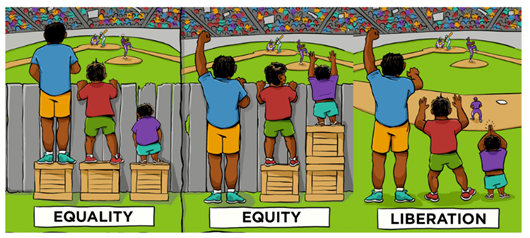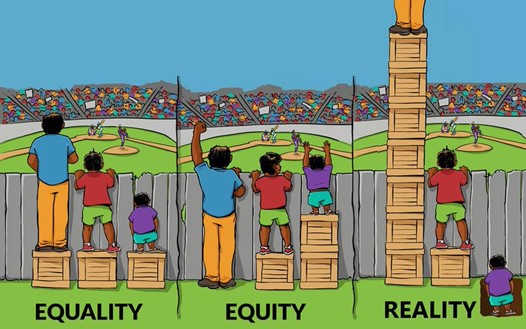William Arnone, Chief Executive Officer
A year ago (February 2020), I wrote a piece on the importance of values-driven social insurance. In this piece, I asked:
What are the underlying values that make social insurance resonate with most Americans? Is there a normative framework through which social insurance might be viewed? Will values emerge as a focus of the 2020 election?
At the time, my focus was on “Egalitarianism” and “Equality”, as well as “Individualism” and “Individual Responsibility.” As I noted then, others have argued that “Dignity”, “Self-Reliance”, “Earned Right”, and “Fairness” are foundational to social insurance policy design. “Equity” as a value or distinct concept was not included, although equity has long been part of the social insurance field’s lexicon and of the Academy’s work. In 1999, for example, an Academy Study Panel used equity as a criterion for examining Medicare reform options. In 2016, the Academy held a half-day conference on Advancing Equity and Inclusion Through Social Insurance. Equity is also a key concept in our work on universal paid family leave. The forthcoming final report of the Academy’s Economic Security Study Panel (which launched in the fall of 2019) will include a section on equity policy, with options to address the severe inequities among demographic groups.
With all that U.S. society has experienced over the past year, there is a renewed focus, across public and private sectors, on equity. U.S. public policy may be shifting towards embracing equity, as distinct from equality, more than we have seen in many decades. What does this mean for our work on social insurance programs and policies?
Equity in today’s public discourse
In a video posted to Twitter a few days before the 2020 election, now Vice President Kamala Harris wrote: “There’s a big difference between equality and equity.” In the video (with over 6.4 million views), Harris states:
“Equality suggests ‘Oh, everyone should get the same amount.’ The problem with that: Not everybody’s starting out from the same place. So if we’re all getting the same amount, but you started out back there and I started out over here, we could get the same amount, but you’re still going to be that far back behind me… Equitable treatment means we all end up at the same place.”
This largely echoes a 2019 video on “Equity and Equality,” posted by Susan K. Gardner, as part of the University of Maine’s Rising Tide Center. This video defines equity as: “Giving everyone what they need to be successful,” which is distinct from an approach of equality and giving everyone the exact same thing. This video also includes the meme below, which was first created in 2016 (and the meme itself is based on an illustration from 2012):

Source: http://madewithangus.com/portfolio/equality-vs-equity/ (Illustration by Angus Maguire with the Interaction Institute for Social Change and Center for Story-based Strategy)
Soon after this was first released, other versions appeared, including this:

Source: https://twitter.com/urbandata/status/695261718344290304
(Another version of the illustration above might show “Reality” with a fence of varying height, as a result of systemic racism and policy failures.)
The 2019 Gardner video concludes with a 2014 quote from physician Naheed Dosani (who himself references the original 2012 illustration):
#Equality is giving everyone a shoe. #Equity is giving everyone a shoe that fits.
In a June 2020 piece, MentalFloss writer Ellen Gutoskey cites the George Washington University’s Milken Institute School of Public Health: “Recognizing the difference between equality and equity is important in just about every sphere of life: public health, politics, education, racial justice…” She offers the following example:
“If each public school in a certain county receives 150 new laptops, that’s technically equal. But it doesn’t factor in that some of those schools might be located in high-income districts where most of the students already have their own laptops. Instead, officials should allocate the devices according to which schools have the greatest need for them—that way, they can minimize the chance that dozens of laptops will end up gathering dust at one school, while another doesn’t have enough to go around. To summarize, equality is about dividing resources in matching amounts, and equity focuses more on dividing resources proportionally to achieve a fair outcome for those involved.”
In 2011, speaking at the Academy’s 23rd annual policy conference, Angela Glover Blackwell said: “The equity agenda is the agenda that is going to take us safely and productively into the future.”
The Biden-Harris Administration
Nearly a decade later, on his first day in office, President Biden signed a series of executive orders, including one launching a government initiative to establish “equity across federal policymaking and rooting out systemic racism and other barriers to opportunity from federal programs and institutions.” He then followed by signing four executive actions specifically aimed at promoting racial equity — related to fair housing, mass incarceration and private prisons, tribal sovereignty, and xenophobia — policy goals which the White House described as “just the start.”
On the pandemic front, the Biden Administration has also established a COVID-19 Health Equity Task Force to address racial disparities in the pandemic. This Task Force is expected to recommend ways to provide more funding for population subgroups who have been particularly affected by the pandemic based on analyses of needs by such factors as race, ethnicity, geography, and disability. It will also address vaccine hesitancy.
Writing in McClatchy, Bailey Aldridge noted that “while the word equity has been found in many of Biden’s executive actions, the word equality has largely been absent.” Susan Rice, who heads the White House’s Domestic Policy Council, recently stated during an MSNBC interview: “We’re focused on racial justice and equity. Equity is racial but it’s not just racial, it’s for everybody who has not had the benefits of a system that has not served everybody. This is actually the opposite of dividing us, this is about bringing everybody in and being inclusive.”
Social Security Policy
Within Social Security policy, there has always been the need for a balance – and there is often a tension – between individual equity and social adequacy. In this context, the former means that benefits are based on one’s earnings history and contributions, while the latter refers to benefits that are sufficient to meet one’s financial needs. The group equity lens in Social Security debates has also often meant a concern over intergenerational disparities between relative lifetime contributions made and benefits received.
In his classic book, Social Security (fourth edition, University of Pennsylvania Press, 1993), Academy Founding Board Member Robert Myers included an appendix, “Views on Individual Equity and Social Adequacy.” He described social insurance as aiming “primarily at providing society with some protection against one or more major hazards which are sufficiently widespread throughout the population and far-reaching in effect to become ‘social’ in scope and complexion.” He added that these risks, “if not guarded against through some organized means… produce large dependency problems that take their toll not only of financial but of human values as well.”
Myers also noted that social insurance’s “first objective in the manner of benefits should be that those covered by it will, so far as possible, be assured of that minimum income which in most cases will prevent their becoming a charge on society.” He then pointed out: “not until this is accomplished should financial resources (whatever, if anything, may remain of them) be considered as available to provide individual differentiation aiming at equity.” In short, Bob Myers concluded that “of the two principles, adequacy is the more essential and less dispensable.”
Over five years ago, the Academy’s Board of Directors identified inequality, i.e., disparities in income and wealth, as the overarching strategic theme to guide our policy and research work. Our 2017 Report to the New Leadership and the American People on Social Insurance and Inequality reflected that theme. This report also noted how policymakers, throughout Social Security’s history, have sought to balance individual equity (i.e., that benefit amounts are fair to all contributors based on earnings during their working years) with social adequacy (i.e., that benefits are sufficient for the lowest wage workers and their families). Today, some are calling for a restoration of Social Security’s minimum benefit as a form of equity, while its origins were viewed more as an example of adequacy.
The Academy’s Focus
Academy Members, from the late Rashi Fein (an architect of Medicare) to some of our newly-elected Members, have helped to define some of the systemic barriers leading to disparities, and helped to deepen our understanding of equity as a response. (Fein and others are recognized for pushing our thinking on health equity in particular). Other experts, including some Academy Members, will continue to question the value of equity as a primary approach to social and economic policy.
If “equity focuses more on dividing resources proportionally,” then those of us working on policy research and design (as well as implementation) face a number of questions including: What are the correct proportions, and do they shift over time? Are there more than one option or method for dividing resources, and if so, what are the tradeoffs?
As the equity lens continues to guide domestic policy, further refinements and clarifications of its implications will no doubt emerge. The Academy will reflect new insights into the dimensions of equity across our activities, including as noted above, in the final report of our Economic Security Study Panel and at our annual conference (which launches our new Campaign for Pathways to Economic Security), as well as our Task Forces on COVID-19, Unemployment Insurance, and Older Workers.
As always, we welcome your input in the Discuss section of this post.
 William Arnone is the Chief Executive Officer of the National Academy of Social Insurance. He is a Founding Member of the Academy. He served on the Academy’s Board of Directors from 1986 to 1994, and was Chair of the Academy’s Board of Directors from 2013 to 2016.
William Arnone is the Chief Executive Officer of the National Academy of Social Insurance. He is a Founding Member of the Academy. He served on the Academy’s Board of Directors from 1986 to 1994, and was Chair of the Academy’s Board of Directors from 2013 to 2016.

